As an Amazon Associate I earn from qualifying purchases.
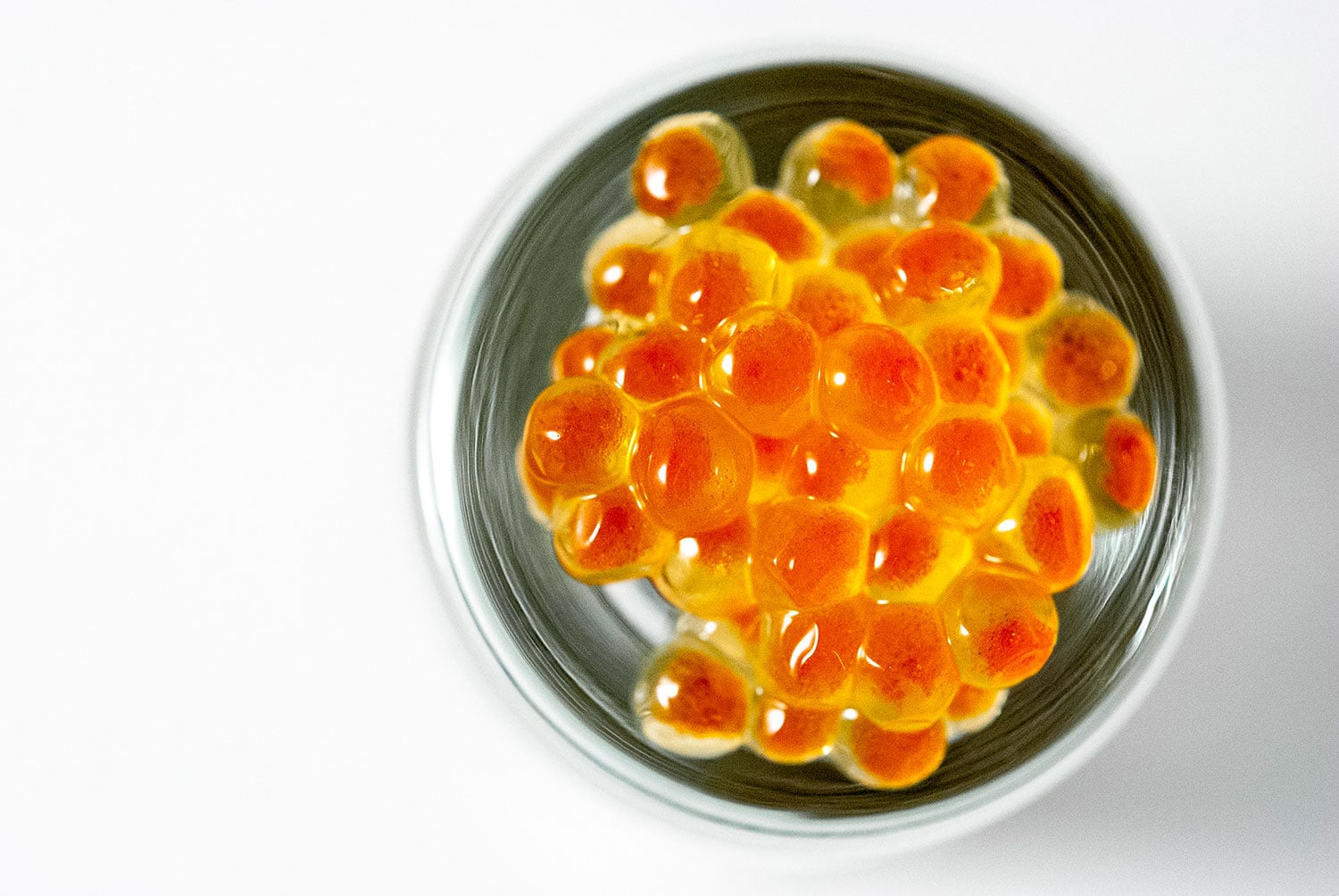
Caviar has always had a hold on me. It is a mysterious ingredient, almost otherworldy; the individual eggs look like jewels from an alien planet. Caviar tastes briny and vaguely floral, and the textural surprise of the pop in your mouth has led more than one writer to liken it to Pop Rocks for adults.
I’ve eaten all sorts of caviar, from spendy Osetra sturgeon caviar to our own California white sturgeon eggs, to Paddlefish roe to salmon roe ikura, to the wonderful little eggs from flying fish (tobiko), capelin and whitefish, which is a golden yellow. I’ve also eaten caviar from trout and char.
Steelhead roe is a particular favorite, as is king salmon roe.
I’d read about a general method of making caviar in a book called The Philosopher Fish, which involves gently removing the eggs from the skein — the membrane holding them together — rinsing them, salting them and drying them. It seemed pretty easy, which alarmed me: How could something so mysterious be so easy to create? It didn’t seem fair.
I delved into some more research, and it is indeed that easy. The art comes in the details: How do you get the eggs out of the skein? How much salt? How long to brine or rub the eggs? What temperature do you store them at?
So I use an amalgam of the methods I’d read about. I brine the salmon roe for a half hour in the fridge. Then I run the skein under hot tap water, which shrinks the membrane and lets the eggs drop into a colander. I then return the eggs to the brine for another 30 minutes. I rinse them off and let them drain in the colander for 15 minutes. Then I package them into a clean glass jar in the fridge. Done!
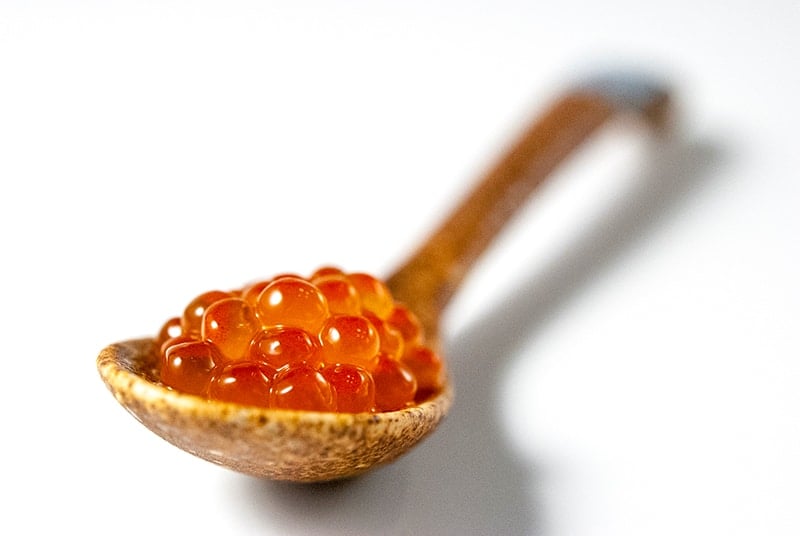
And there is an easier way: Run them over a cooling rack, membrane side up. Either method results in some egg loss, and the hot water trick can sometimes cook the eggs, which is no bueno.
Aren’t they the coolest things ever? I have a hard time not taking them out of the fridge just to look at them. homemade caviar keeps for 2 weeks in the fridge, but I think it gets fishy after about a week.
I prefer my caviar straight, served in a special spoon, so you can linger over the qualities of this caviar versus that one; this is what the Russians do when they serve the three classic sturgeon caviars: Beluga, Sevruga and Osetra. In case anyone cares, I am particularly fond of Osetra, which is pretty close to our caviar made from California white sturgeon.
Remove from your mind the notion that the only good caviar comes from sturgeon.
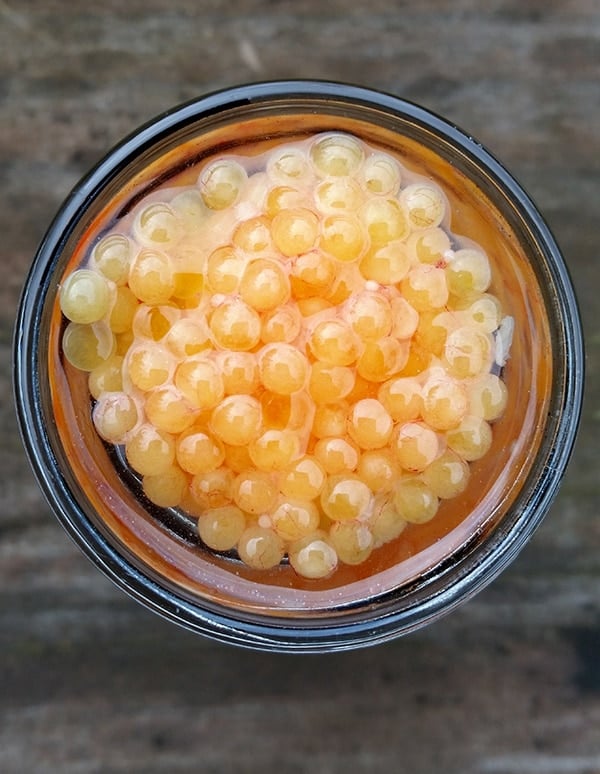
The tobiko and masago you see in sushi restaurants is caviar from the flying fish and the capelin, a kind of herring. It really is like pop rocks. Whitefish caviar is even better, and is a beautiful canary color. Lumpfish is like a larger sturgeon caviar, but trout and salmon caviar is its own thing: large, luxurious, and slightly fatty — I saw thousands of minute fat droplets floating on the top of the brine when I made it.
When combined with a larger dish, caviar can become an accent that makes a good dish great.
I make a pasta dish with flaked salmon, mixed with toasted pine nuts, parsley, shallots, olive oil, Meyer lemon juice — and a spoonful of salmon roe caviar. The color and pop really makes the dish.
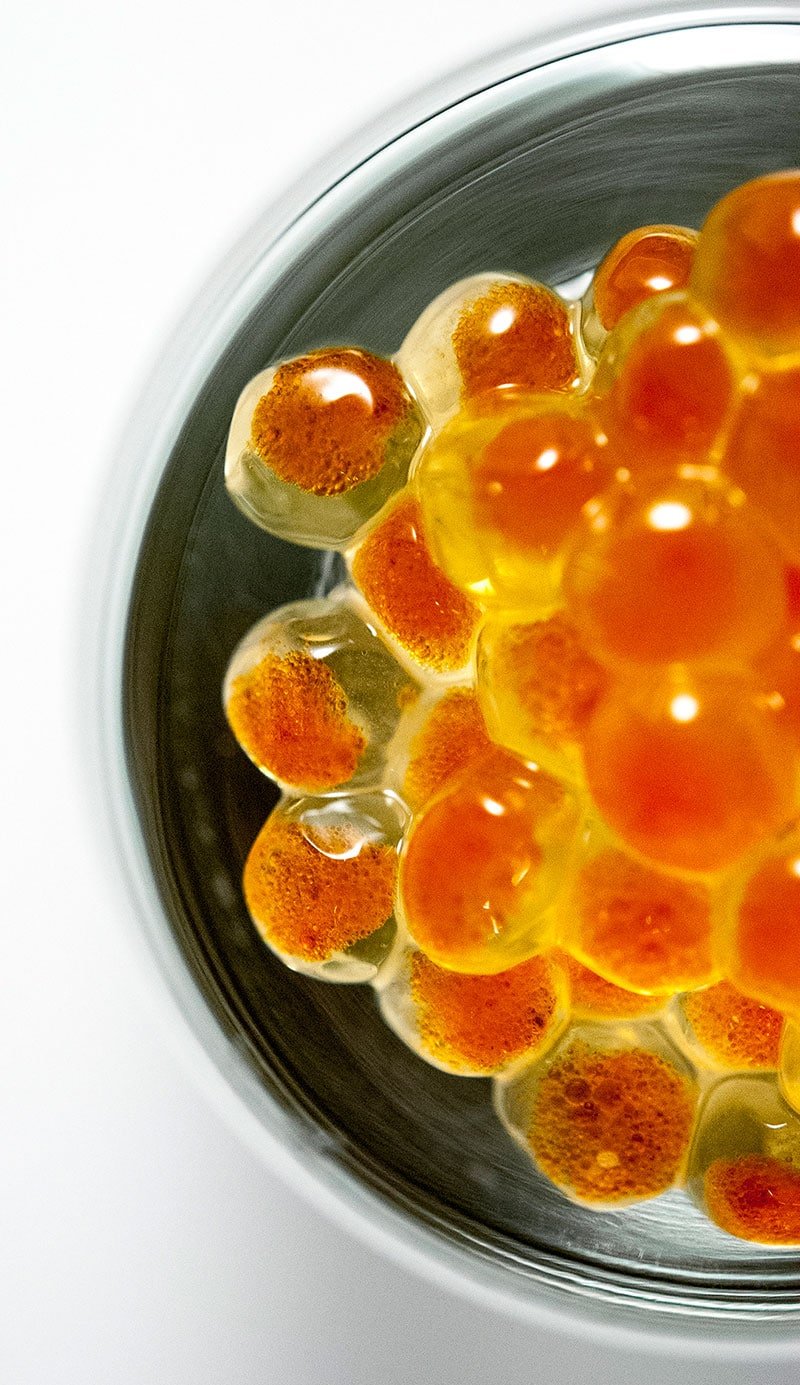
Homemade caviar also works well as a garnish for a simple Japanese dish of salmon or trout wrapped in buttered foil with some matsutake (or other) mushrooms, sake and lemon slices, then baked it for 20 minutes. Damn good.
Will this method work for other fish roes? Yep. I imagine the salting times and care you will need to dislodge the eggs will change, but the basic technique shouldn’t change.
How to Make Caviar
Ingredients
- 1 full skein of steelhead, trout or salmon roe
- 1/2 cup kosher salt
Instructions
- Mix the salt and 1 quart ice-cold water until the salt is all dissolved.
- Make sure the roe skeins are split, so you have an opening that the eggs can come out. Set up a cooling rack or something else with a wide mesh (chicken wire works, too) over a bowl. Take a roe skein and, with the membrane facing up work the eggs out through the rack. Perfectly ripe eggs will come off easily, unripe ones will require some force. Either way, you will pop some eggs in the process.
- ALTERNATE METHOD: Get the faucet running with warm water roughly 105°F to 115°F, or heat cool tap water to this temperature -- some people fear that hot tap water can add harsh minerals to their food. Either way works. Fill a metal or glass bowl with the warm water. Dunk a few skeins of roe at a time in the warm water. Gently massage the eggs out of the skeins with your fingers under the surface of the warm water. They will float away and sink. Discard the skeins.
- Have a fine-meshed sieve ready. Pour the strained eggs into the strainer to rinse them well with cold water. Pick out clumps or stray bits of membrane.
- Dunk the eggs in the brine for 5 minutes. Taste them and if they are salty enough for you, drain them again. You can brine for up to 30 minutes, but they will be very salty. My preferred brine time is 10 minutes. Spoon carefully into a clean glass jar and refrigerate for up to 2 weeks, but try to eat them within a week or they will start to get fishy.
Notes
Nutrition information is automatically calculated, so should only be used as an approximation.


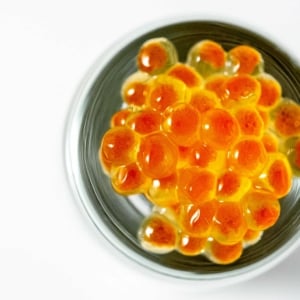

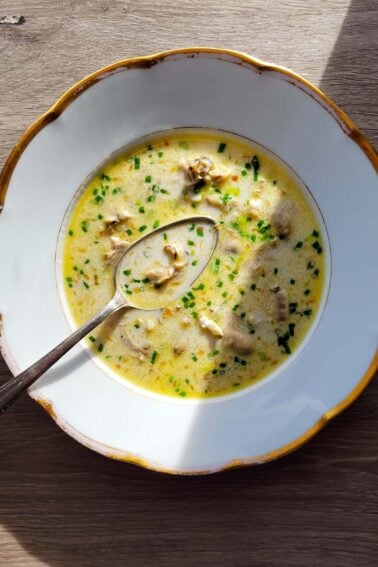


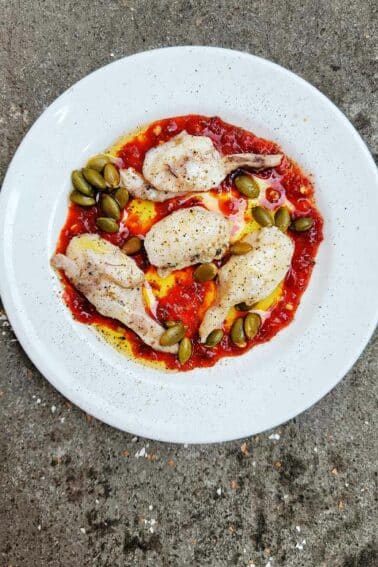
Are you able to do this with freshwater fish? I fish the great lakes and am always sad to see the salmon roe being discarded at the fishing station.
A great recipe ! We tried it today with Shad roe. Delightful.
Great recipe. Thanks, Hank. Made it last night with eggs from a 23-inch hen Missouri River rainbow. Note: Do not make caviar from any gar species. The green eggs are poisonous. But everything else? Have at it. The only way to know is to try.
Tom: Very true about gar eggs! I think there might be one or two other North American fish with toxic or at least foul-tasting roe.
Does this recipe work with mudfish or “Bowfin”?
Will: I’ve never used it on bowfin, but it works on paddlefish.
I have been smoking salmon roe for years and have had great success. Only recently I have tried making trout caviar and it has been delicious. I live near Lake Tahoe and occasionally have access to lake trout roe. Have you made caviar with this, and how was it?
Steven: Not lakers, but most other trout yes.
Thanks Hank. What steps do you suggest to minimize that risk? And how serious is the risk, in your opinion. I read an FDA warning that said it is rare for parasites to be in eggs in salmon. Most often any parasites associated with eggs are contained within the skein membrane. That was for oceangoing fish though. I’m sure steelhead would have a similar issue once they hit fresh water. I would really like to try this and I have access to copious amounts of Kokanee. , I’ve just done my bouts with parasites from time overseas and not excited about reliving my younger days.
Are there any concerns with using freshwater fish for caviar? Parasite issues or the like?
Rob: I’ve not read about any, but I bet there is a risk.
Hello Hank, I will be returning to Sitka AK this coming August to do some fishing for silver salmon. These are bright ocean run fish that are fat and often full of roe. The lodge I stay at will clean, vacuum seal, and pack our fish for transport (frozen) back to our home in Georgia. On past trips the roe was either discarded or our captain would use the skeins for halibut bait when bottom fishing. I would love to bring some of this roe home and try your technique for making caviar but was wondering if the freezing would ruin it. Can it be frozen prior to processing?
George: It can be frozen, but I have never liked it thawed out. There is a trick to it, apparently, that I have yet to learn.
Has anyone tried ling cod roe? It’s salting in my brine right now. Small white eggs.
Ellen: I have not. Let me know how it turns out!
Thanks for the recipe!! What if you cannot prepare the roe right away? Does it work to freeze the roe and then defrost when you’re ready to prepare it? I am getting some roe from my fisher/father-in-law, and so I won’t have access to it immediately. Thanks!
Denise: Nope. You need to make it straight away. It does not keep well.
Salting can kill those parasites but it needs lot of salt to the level that too salty.
Will the salting of the roe kill parasites? as in, would you be safe from tape worms and other little critters?
I found your article after I read one that said that the fish should not die before the roe is removed. Upon death, the fish excretes something into the eggs to make them bitter. Do you find this to be true?
Trina: No, never. I’ve done this scores of times and never had a problem.
can frozen roe be used after its thawed?
Riochard: I have not had good success with it, sorry.
I live near a fish hatchery that always seems to have a lot of extra trout eggs, I’ll take a trip down there next spring to see if I can pry a couple pounds off them.
Thanks for a really interesting article!
In my opinion nothing beats https://en.wikipedia.org/wiki/Kalix_L%C3%B6jrom
but I’m also a big fan of burbot roe.
I made caviar for the first time this year, just a few weeks ago. I caught a couple of Pink Salmon in the Skykomish River in Washington and kept one. It was about a 7-pound fish and when I cleaned it, there were these beautiful eggs inside. Decided I had to make caviar out of it so I gave them a quick rinse; put them in a bowl; and set them aside while I filleted the fish. After filleting and putting the fish in the fridge, I hopped on the computer to find out how to turn these eggs into caviar.
I found a number of methods most saying to use the cake/pastry cooler with 1/4″ mesh to separate the eggs. Didn’t have one and the stores close by didn’t carry them. Found one method using hot water, so I did that. Ran hot tap water into a bowl, submerged and started to massage the eggs. They came loose pretty easily but changed to a milky color in the hot water. Instructions said, don’t worry, they will change back and they did.
Once they were all in the bowl, I drained the bowl and filled with cold water (the small pieces of skein will float to the top). Then kept filling with cold water and dumping the top layer off until there were almost no little bits floating at all. Picked out the last few floaters and drained through a strainer again. Not hard to do at all, just takes about 7 to 10 minutes to get there. The eggs start losing that milky color when you use the cold water but really look good at the end of it all.
I then mixed a brine of 3-cups of COLD water and enough salt stirred into it to saturate the water leaving just a little undissolved salt in the bottom of the dish. Then I added 2 tablespoons of granulated sugar and 2 tablespoons of soy sauce. After mixing well, I added the eggs to the brine and let them sit for 10 minutes. After 10 minutes, you’ll want to take a few eggs out, rinse them well in cold water to get the salt covering off the outside, and taste them. If they are not salty enough, put them back in the brine tasting them every 5 minutes until you like the taste. If they are too salty, fear not, it is easy to fix. Pull them out of the brine solution, rinse in cold water, and put into a bowl of clean fresh cold water for 5 to 10-minutes, tasting them every 5-minutes. Because the eggs surface is still permeable, this will leach the salt out of it.
Once you get the taste where you want it, rinse the eggs well and leave the eggs in a strainer over a bowl. Then fill a ziplock bag with cold water, set it on top of the eggs in the strainer and set the whole assembly in the refrigerator for 12 hours (overnight). The water-filled zip-lock bag compresses the eggs and the remaining water pools in the bottom of the bowl.
When I took them out of the fridge 12-hours later I was rewarded with delicious, beautiful, translucent orange pearls of salmon caviar. I ate them on crackers with cream cheese that evening and made some ikura sushi the next day so we could eat a fair amount of them before we had to leave town for two-weeks.
I put the rest in the freezer, and just now pulled them out of the freezer and put them in the fridge to slowly thaw. Supposed to take 8 to 12 hours to thaw out. We’ll see how that goes. Hope it goes well because I had to freeze about 1/2 of the batch and I’d sure like to eat some more of these!
Thanks for this recipe, it is very similar to mine expect I learned how to do this in Japan so I used soy sauce mixed with mirin and water as my brine. The flavour of the eggs isn’t hidden at all and you get a nice fermented back taste from the soy sauce. Use about the same ratios you already use, I would just use the soy sauce until the water turns a light brown.
I just tried this method and the caviar was very tasty. I was wondering if you have found a way to preserve for later use since last year…either by canning or freezing methods. I have over 3 gallons of roe and when I have just frozen the eggs, they don’t look good. Was hoping freezing or canning processed caviar would have a different outcome. If not, will just have to enjoy now and leave it at that.
Hank I will be on Lake Michigan fishing King Salmon this weekend. I’ve heard that there could be parasites in fresh water fish? Any thoughts on this or can I use the roe from these kings to make caviar?
Brad: I’ve done it with freshwater trout before. I think there is a risk, but that it’s smaller because a) parasites tend to not be in the eggs, and b) you are salting the eggs, which gives you some protection.